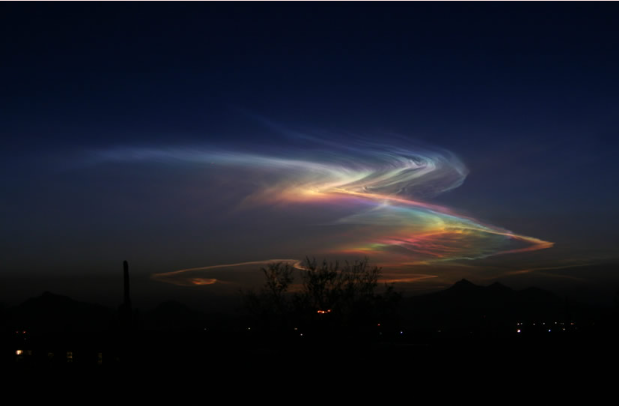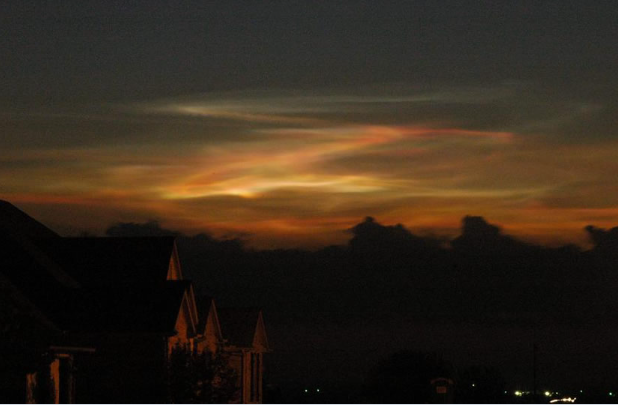Rocket Trails
Rocket Trails: A Spectacular Display of Atmospheric Optics
Rocket trails, also known as contrails or vapor trails, are a fascinating phenomenon that occurs when rockets launch into the sky. These trails extend high into the stratosphere and mesosphere, remaining visible long after the sun has set at ground level. They are not only a testament to human ingenuity but also provide a captivating display of atmospheric optics.
To produce the vivid iridescence seen in rocket trails, the particles or droplets in the exhaust must have similar sizes and be at least several microns across. This similarity in size allows them to diffract sunlight, creating a stunning array of colors. As the sunlight interacts with these tiny particles, it undergoes diffraction, causing the light to spread out and form a spectrum of colors.
One of the key factors that contribute to the beauty of rocket trails is the influence of high altitude winds. These winds deform and twist the trails, giving them their unique shape and appearance. They can carry the trails over long distances, sometimes even hundreds or thousands of miles away from the launch site. This means that people far from the actual launch can still witness the mesmerizing spectacle of rocket trails in the sky.
The images captured by photographers like Robert Koch provide a glimpse into the sheer beauty and complexity of rocket trails. In one such image taken over Arizona, a rocket trail created by a Minotaur solid-fueled rocket launched from Vandenberg Air Force Base in California is visible. Despite being 580 miles away from the launch site, the trail is still clearly visible due to its high altitude and the diffractive properties of the exhaust particles.
It's important to note that rocket trails require specific atmospheric conditions to form and be visible. For example, the trails must be high enough in the atmosphere to remain in sunlight even after sunset at ground level. Additionally, the presence of moisture or ice crystals in the atmosphere can enhance the visibility and iridescence of the trails.
Rocket trails not only serve as a visual spectacle but also have practical applications. Scientists and meteorologists can study these trails to gain insights into atmospheric conditions, wind patterns, and even the composition of the exhaust particles. By analyzing the behavior and characteristics of rocket trails, researchers can improve their understanding of atmospheric dynamics and refine weather forecasting models.
In conclusion, rocket trails are a captivating display of atmospheric optics that showcase the interplay between sunlight, particles, and high altitude winds. Their vivid iridescence and unique shapes make them a sight to behold, even from great distances. As we continue to explore and push the boundaries of space, let us not forget to appreciate the beauty that arises from our endeavors. Rocket trails remind us of the marvels that can be found both on Earth and beyond.

Rocket trail high over Arizona imaged from Tucson April 14, '06 by Robert Koch. The trail was made by a Minotaur solid fuelled rocket launched from Vandenberg Air Force Base in California 580 miles to the west. High altitude winds contort the trail and its small exhaust particles diffract sunlight into vivid iridescent colours. Image ©Robert Koch, shown with permission.
Rocket exhaust trails extend high into the stratosphere and mesosphere. They are high enough to remain in sunlit long after the sun has set at ground level.
To diffract sunlight and produce the vivid iridescence, the particles or droplets must have similar sizes and be at least several micron across.
High altitude winds deform and twist the trails and carry them long distances. The trail below was 1300 miles from the launch.

Note: this article has been automatically converted from the old site and may not appear as intended. You can find the original article here.
Reference Atmospheric Optics
If you use any of the definitions, information, or data presented on Atmospheric Optics, please copy the link or reference below to properly credit us as the reference source. Thank you!
-
<a href="https://atoptics.co.uk/blog/rocket-trails/">Rocket Trails</a>
-
"Rocket Trails". Atmospheric Optics. Accessed on May 2, 2024. https://atoptics.co.uk/blog/rocket-trails/.
-
"Rocket Trails". Atmospheric Optics, https://atoptics.co.uk/blog/rocket-trails/. Accessed 2 May, 2024
-
Rocket Trails. Atmospheric Optics. Retrieved from https://atoptics.co.uk/blog/rocket-trails/.